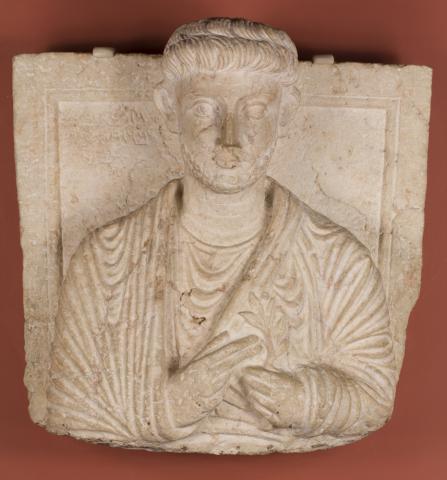Funerary Portrait: Pazal, son of Zabda, son of Zabda Pazal
Funerary Portrait: Pazal, son of Zabda, son of Zabda Pazal
Late Antique (Palmyra), 200 CE
limestone
height 59.7 cm
width 55.9 cm
depth 22.9 cm
Inscription in Aramaic
Portland Art Museum European Collection, 54.1
Gift of Mr. Aziz E. Atiyeh
Melissa Medefesser, Medieval Portland Seminar Student, 2015
Like most Palmyrene funerary portraits, Pazal, Son of Zabda, features a single figure sculpted in high relief limestone. Busts such as this served as decorate covers for niches inside tombs. Carved Aramaic inscriptions above the right shoulder identify the figure as Pazal ('Squinter'),[1] whose name translates to squinter. The figure is dressed in a Greek himation and chiton, standard male attire in Palmyrene funerary art, and his right arm is wrapped and resting in a traditional arm-sling pose. Two fingers on his its right hand are pointed at a forty-five-degree angle directly at a palm leaf, a symbol of immortality, held by his in its left hand.[2] These were common gestures and attributes in Palmyrene busts and likely convey little about the individual's identity.[3]
Stylistic aspects place this sculpture around 200 CE. Two concentric circles enclosed in heavy eyelids define the eyes while slightly curved engraved lines mark the eyebrows. The hair is thick and naturalistic with snail curls accenting the beard. Beards became a trend in Palmyra when Emperor Hadrian visited in the second century; they subsequently became a common feature on male Palmyrene funerary busts.[4]
Mr. Aziz Atiyeh donated this sculpture, along with two other Palmyrene busts, to the Portland Art Museum in 1953.[5]
Notes
[1] Collection Notes, File 54. 1-3, Archives Department, Portland Art Museum.
[2] Francis J. Newton, "Three Tomb Sculptures from Palmyra," Notes on the Collection, no. 5 (1964-65), Portland Art Museum.
[3] Malcolm A.R. Colledge, The Art of Palmyra (Boulder: Westview Press, 1976), 68.
[4] Harold Ingholt, Palmyrene and Gandharan sculpture; an Exhibition Illustrating the Culture Interrelations Between the Parthian Empire and its Neighbors West and East, Palmyra and Gandhara (Yale University: New Haven, 1954) 2.
[5] Newton.
Bibliography
Colledge, Malcolm A.R. The Art of Palmyra. Boulder: Westview Press, 1976.
Ingholt, Harald. Palmyrene and Gandharan sculpture; an Exhibition Illustrating the Culture Interrelations Between the Parthian Empire and its Neighbors West and East, Palmyra and Gandhara. Yale University: New Haven, 1954.
Newton, Francis J. "Three Tomb Sculptures from Palmyra." Notes on the Collection, no. 5 (1964-65). Portland Art Museum.
Portland Art Museum. Palmyrene Sculptures. File 54. 1-3. Archives Department.

